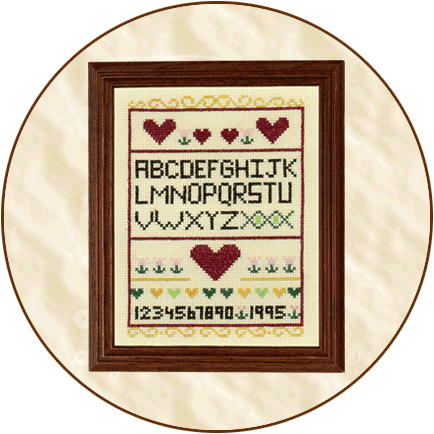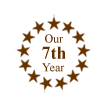.
Continued from product description
on Home Crafts' Page Two...
Historical
Background: Samplers were mostly used as a notebook of
ideas and stitches in the 16th century. During the 17th century,
this was not as important a feature because books were being
published featuring models and embroidery motifs. By the 18th
century, samplers had become just a piece of decorative art.
Today, the sampler is still ornamental, but is generally used
to portray ancestral information or personal feelings in rhymes
or verse.
Cross-stitch is a form of embroidery, indeed one of the oldest
forms of embroidery. The ancient Egyptians and Phrygians used
cross-stitch. It was also used in Austria, Denmark, the Greek
Islands, Norway, Romania, Sweden, and Turkey. The word "sampler"
comes from the Latin word "exemplum" ("model to
imitate"). The French word for sampler is "marquoirs"
from "point de Marque," which means "cross-stitch"
because it marked clothes. The Italian word for sampler is "imparaticci,"
which means "practice for young girls."
"There was one piece of needlework which was done by
every little girl who was carefully brought up: she sewed a sampler."
This statement from "Child Life in Colonial Days" says
it all. The sampler was an important part of every young girl's
life. To grow up into a useful woman, a girl must learn to sew
and making a sampler was a must! A sampler usually featured the
alphabet and numerals, and often a Biblical scripture verse,
a small picture or two, and the name and date of the maker. Samplers
made by older girls might feature a collection of stitches they
wanted to remember, or stitches of a particular alphabet style.
These works were done on strong, loosely woven canvas with colored
silk threads or wool threads. Needlework, such as stitching a
sampler, was also taught in most schools for girls, along with
spinning, knitting, straw-works, embroidery, cross-stitch, openwork,
and tambour.
The oldest surviving sampler is dated 1598 and is known as
the "Jane Bostocke's Sampler." This sampler is now
displayed at the Victoria and Albert Museum in London, England.
The oldest surviving American sampler was stitched by Loara Standish
(circa 1636). Most of the samplers, including hers, that have
survived in America have been from the North due to several factors.
The heat and humidity in parts of the South deteriorated the
fabric (if insects did not get to it first). The North also produced
more samplers than the South because northern girls were indoors
more during the winter months and needed an occupation, whereas
girls in the South were outside, learning to ride horses, fish,
and taking long walks. General Sherman and his Union army destroyed
much property in the South, including many forms of needlework
and, after the Civil War, there was a shortage of many materials
and the time that was available for needlework was now used for
practical sewing or repairing.
For more information, please go to the historical backgrounds
for our Quilt Pattern Cross-Stitch Bookmark
(4202) and our Amish Cross-Stitch Bookmark
(4203).













